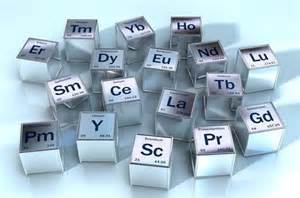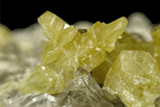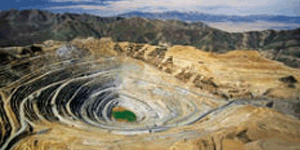 Rare earth
Rare earth- As defined by the International Union of Pure and Applied Chemistry (IUPAC), rare earth elements are a set of 17 chemical elements in the periodic table, including the 15 lanthanides plus scandium and yttrium. Their abbreviation is REE. The 17 elements are considered together as one group due to their similar chemical properties, which make them indispensable and non-replaceable in electronic, metallurgy, magnetic, catalytic and some other high-technology areas. Despite rare earth elements being relatively abundant in the Earth’s crust, the ores containing REE vary and their distribution is scattered. Therefore, it is not common to find them in commercially viable concentrations, hence they are named rare earth elements. The 17 elements are: Sc, Y, La, Ce, Pr, Nd, Pm, Sm, Eu, Gd, Tb, Dy, Ho, Er, Tm, Yb and Lu.
As essential and functional materials, rare earth elements have been named “The Vitamins of Modern Industry”.

- REE: discovery and industry development
- The complex compositions of the two starting minerals cerite and gadolinite (ytterbite) are revealed in the flow chart of discoveries of the elements. Whilst at the time cerite was the first of the rare earth minerals to be discovered, it was in ytterbite, (later renamed gadolinite)...

- REE: minerals and classification
- In the earth’s crust, instead of existing as free metals, rare earth elements usually occur in the minerals of mixtures of various rare earth elements and nonmetals. More than 200 kinds of minerals have been discovered to contain essential or significant REE currently, and bastnaesite, monazite and xenotime...

- China Rare earth: dilemma
- REE can be widely used in many areas including magnets, catalysts, metal alloys, electronics, glass, ceramics, new materials and some other high-technology fields. Meanwhile, rare earth extraction is one of the most environmentally destructive and toxic of all mining practices...

- Rare earth: uses
- As rare earth elements are a group of 17 elements with many irreplaceable properties, REE can be widely used in many areas including magnets, catalysts, metal alloys, electronics, glass, ceramics, new materials and some other high-technology fields...

- Rare earth: resource distribution and production
- Rare earth minerals occur in the form of bastnaesite, monazite and xenotime and some other minerals. As shown in the U.S. Geological Survey, Mineral Commodity Summaries, February 2014, REE reserves worldwide total 140 million tonnes. They are distributed mainly in China (55 million tonnes), the United States (13 million tonnes)...

- REE: industrial technology
- As this group has 17 kinds of elements, the applications of rare earth elements are diversified: compounds from chloride 46% purity and 99.9999% of single rare earth oxides. The products are various. Details of their separation methods and smelting process are as follows...

- Rare earth: news
- China is the largest producer of rare earth elements in the world. China's caps on exports of rare earth elements break global trade rules, the World Trade Organization (WTO) ruled. Rare earths are used in gadgets such as DVDs and mobile phones, and China accounts for more than 90%...

- REE: health and environment effects
- Whether REE are harmful or not depends on the amount and duration of exposure. Usually, only when a person is exposed to a great quantity of REE over a long time, is it possible the result will be serious. For example, the Bukit Merah mine in Malaysia has been the focus of a US$100 million clean-up...

- Rare earth: recycling
- In recent years, with zinc smelting technologies continually improving, consumption of zinc as a raw material has been huge. As a result, zinc ore resources have declined and metal zinc is facing serious raw material shortages...

- REE: industry associations and famous companies
- The Association of China Rare Earth Industry was set up on 8th April, 2012 with the aim of spurring healthy development in the sector. The association, consisting of 155 members that include industry giants Aluminum Corporation of China and China Minmetals Corporation...
- Contents
- Reference
- Rare earths--U.S. Geological Survey, Mineral Commodity Summaries, February 2014
- Rare earth elements--Periodni.com
- Rare earth elements--Wikipedia
- Rare earth element 101 April 2012
- Industry Application of Rare Earth Elements--Great western Minerals Group
- Rare Earth Elements Ores and Minerals--Tasman Metals Ltd
- Rare Earth Recycling--Molycorp
- Rare earths recycling on the rise--Mining.com
- Rare Earth Elements: A Review of Production, Processing, Recycling, and Associated Environmental Issues--U.S. Environmental Protection Agency
- UN investigation into Malaysia rare-earth plant safety--BBC News
- Malaysians' latest drive against Lynas plant--Financial Review
- China sets up rare earth association to regulate development--Xinhuanet
- The Chinese Society of Rare Earths
- United States Magnetic Materials Association
- Kenya's $100 billion hidden mineral deposits--The East African
- Samsung investing in rare earth alternatives--Mining.com
- WTO: China rare earth caps 'break rules'--BBC News
- EU challenges China's rare earth export restrictions--Europa.eu
- WTO rules against China on rare-earth exports--Global Times
- Rare Earth Recycling Takes On New Luster--Forbes

